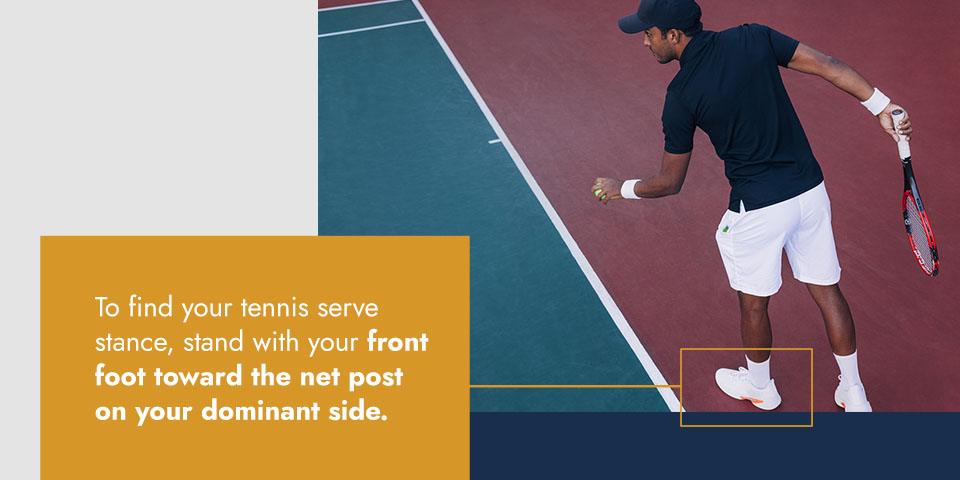
Your serve is the only part of a tennis match where you’re in complete control. Sometimes, you can even serve an ace — winning an immediate point with a powerful, well-placed serve. If your opponent returns your serve, you’ve still managed to limit their options and put yourself in the best position for your next shot.
Refining your serve is one of the best ways to improve your tennis results. To do that, you need to understand the technique you’re trying to achieve.
Your serve is one of the most crucial yet complex parts of your tennis skill set. These eight tennis serve tips will help you master it one step at a time.
There’s more than one way to hit the perfect tennis serve. Top players often practice at least two different serves to use during matches. This helps keep the opponent on their toes and target their weaknesses. The most common serves are:

To find your tennis serve stance, stand with your front foot toward the net post on your dominant side. Your back foot should be parallel to the net. Adjust your back foot’s toes and your weight distribution for stability. Starting from this position, you can adapt your stance depending on where you want to place your serve.
The simplest and most explosive approach to tennis serve footwork is the platform stance. This involves keeping your feet in position throughout the serve while you rotate your hips and shoulders to execute the swing. Some players prefer the pinpoint stance, where you bring your back foot nearer the front foot during the toss and push your body upward toward the ball to hit it.
Many beginners gravitate toward a forehand tennis serve grip. Instead, work on developing a continental grip. This method allows you to execute a variety of serves with greater power and control. Use these three tips to find your continental grip:
Before hitting the ball, you need to toss it in the air with your nondominant arm and prepare a backswing with your racquet arm. Getting your tennis serve toss and backswing in shape is essential to a consistent serve. Here’s how you can do that:
Now you’re set up to hit your serve!
Power is important for an effective serve, especially when aiming for an ace. To increase your tennis serve power:
When you’ve reached the trophy position and the ball is at peak height, it’s time to time your swing:
Practice your placement and timing to send the ball 1-12 inches over the net. Use your foot placement and body rotation to aim your serve.
Following the steps above, if your racquet’s contact with the ball is dead center, you’ll execute a flat serve. This is a great fundamental serve to start with and remains a popular first serve for professionals.
If you want to challenge your opponent by introducing some tennis serve spin for variation, you can do that mainly by adjusting the racquet’s contact angle with the ball. For a slice serve, tilt the racquet’s surface 10-15 degrees and aim to brush the side of the ball. For a topspin serve, aim to make contact while brushing the racquet up along the ball’s surface from the bottom. You want to send the ball’s 6 o’clock point spinning quickly toward its 12 o’clock point.
Now you know what goes into a great tennis serve. But the only way to truly master it is to practice regularly. Find a tennis club near you to practice your serve, paying attention to all the elements discussed in this guide.
If you’re serious about improving your tennis serve, try to practice at least three times a week and connect with a coach who can help refine your technique.
If you live in Central Pennsylvania, Colonial Country Club in Harrisburg is the perfect place to practice your serve. We offer our members four courts, lighting for evening matches and a classy patio bar for post-match refreshments. When you become a member, you get free access to all our tennis, golf and swimming facilities.
If you’re looking for one-on-one tennis mentorship, you can sign up for coaching with former Grand Slam competitor Maja Palaversic. With over two decades of experience, Maja is a certified coach passionate about helping players of all ages and levels improve.
Become a member today to practice your serve at Harrisburg’s finest tennis courts.